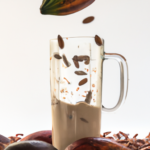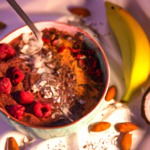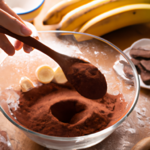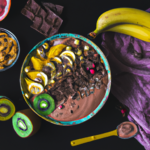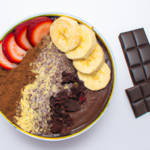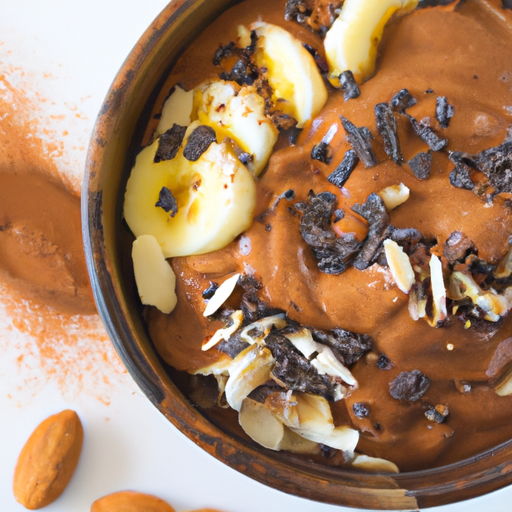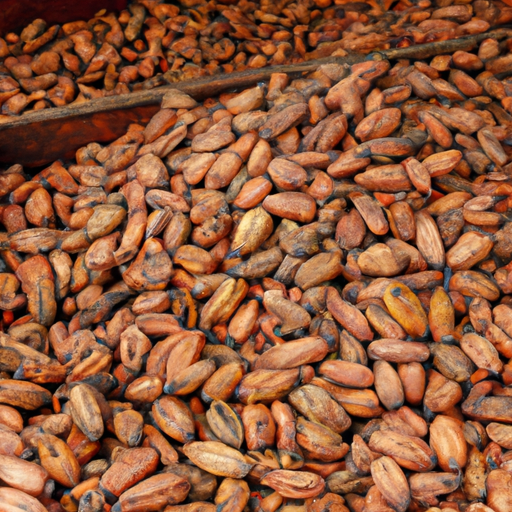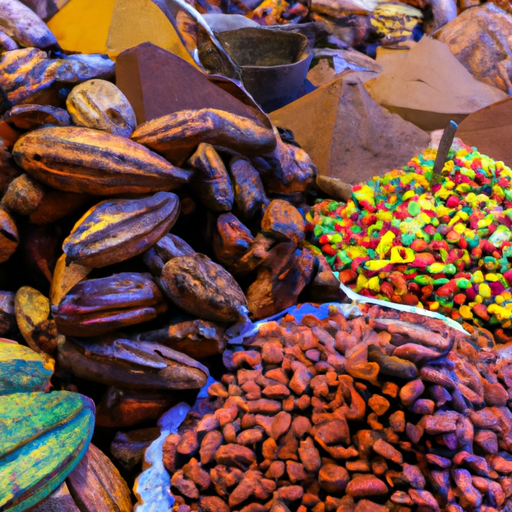Picture beginning your day with a luxurious, creamy smoothie that not only pleases your taste buds but also provides nourishment to your body. Adding raw cacao to your morning routine can elevate the experience, turning a simple smoothie into a decadent delight. It’s the perfect secret ingredient that takes your ordinary smoothie to a whole new level, tempting your senses with its delicious, chocolatey taste.
But how much raw cacao should you actually add to your smoothie? In this article, I will guide you through the world of raw cacao and help you determine the perfect amount to achieve that perfect balance of taste and health benefits.
We will explore different smoothie recipes, consider your personal preferences, and discuss important health considerations. So, grab your blender and get ready to discover the wonders of raw cacao in your smoothie journey.
Key Takeaways
- Raw cacao is a nutritious ingredient for smoothies as it retains its nutritional value and is packed with antioxidants, vitamins, and minerals.
- When using raw cacao in smoothies, it is recommended to use a high-quality blender to break down the fibrous texture of fruits and create smooth and velvety smoothies.
- Green smoothies with raw cacao can provide antioxidants and natural mood boosters, and it is recommended to include 2 cups of greens per serving for optimal nutrition.
- Individuals with caffeine sensitivities should consult their healthcare provider before consuming raw cacao in smoothies, as it contains lower caffeine levels compared to coffee or energy drinks.
What is Raw Cacao?
You’re going to love learning about raw cacao – it’s a delicious and healthy ingredient that you can add to your smoothies!
Raw cacao is derived from the seeds of the cacao tree and is minimally processed to retain its nutritional value. It is packed with antioxidants, vitamins, and minerals that can support heart health, boost mood, and improve cognitive function.
Additionally, raw cacao is known to have a rich, chocolatey flavor that adds depth to any smoothie. If you don’t have raw cacao on hand, you can use unsweetened cocoa powder as a substitute, although it may not have the same level of nutrients.
Now that you know the benefits of raw cacao, let’s move on to determining your taste preferences in the next section.
Determining Your Taste Preferences
When it comes to figuring out what flavors I enjoy, it’s all about exploring my personal palate and finding the perfect combination for my taste buds. One way to do this is by experimenting with different textures and flavors in my smoothies. To help you get started, I’ve created a table below that outlines some popular flavor combinations for smoothies. By exploring these options, you can discover your preferences and create delicious smoothies that you’ll love.
| Fruit | Vegetable | Protein |
|---|---|---|
| Banana | Spinach | Greek Yogurt |
| Mango | Kale | Almond Butter |
| Berries | Carrot | Hemp Seeds |
By exploring flavor combinations and experimenting with different textures, you can create a smoothie that suits your taste preferences. In the next section, we’ll discuss the recommended amounts for different smoothie recipes.
Recommended Amounts for Different Smoothie Recipes
When it comes to smoothies, it’s important to know the recommended amounts for different recipes to ensure you’re getting the right balance of nutrients.
For green smoothies, including leafy greens like spinach or kale, it’s generally recommended to use about 2 cups of greens per serving.
Fruit-based smoothies can be a great way to satisfy your sweet tooth while still getting important vitamins and minerals, but it’s important to watch your portion sizes and limit the amount of added sugars.
Finally, protein smoothies are a popular choice for those looking to boost their protein intake. Aim for around 20-30 grams of protein per serving, which can come from sources like Greek yogurt, protein powder, or nut butter.
Green Smoothies
If you want a truly mind-blowing and energizing green smoothie, adding a generous amount of raw cacao will take it to the next level!
Green smoothies are already packed with benefits, such as providing a great source of vitamins, minerals, and fiber. But when you incorporate raw cacao, you’re not only enhancing the taste but also adding an extra dose of antioxidants and natural mood boosters.
Raw cacao is rich in flavonoids that can improve heart health and lower inflammation. It also contains theobromine, a compound that provides a gentle energy boost without the crash.
To make a delicious green smoothie with raw cacao, try blending spinach or kale with a ripe banana, almond milk, and a tablespoon of raw cacao powder. This will create a creamy and nutritious smoothie that will keep you going throughout the day.
Now, let’s transition to fruit-based smoothies and explore their benefits.
Fruit-Based Smoothies
Indulge in the refreshing and vibrant world of fruit-based smoothies to invigorate your taste buds and boost your energy levels.
When it comes to fruit-based smoothies, one important factor to consider is determining the sweetness level. Different fruits have varying levels of natural sugars, so it’s crucial to strike a balance to avoid overwhelming sweetness.
Experiment with combinations like strawberries, bananas, and pineapple for a tropical twist, or try a berry medley for a burst of antioxidants.
Another key aspect to consider is choosing the right blender. Look for a blender that can easily break down the fibrous texture of fruits, ensuring a smooth and velvety consistency. Investing in a high-quality blender will make a significant difference in the overall quality of your fruit-based smoothies.
Transitioning into the next section about protein smoothies, let’s explore how to incorporate protein-rich ingredients to enhance your smoothie experience.
Protein Smoothies
Get ready to elevate your smoothie game with protein-packed ingredients to create a deliciously nutritious blend.
Protein smoothies are a fantastic way to fuel your body after a workout or as a satisfying meal replacement.
When it comes to protein sources, there are plenty of options to choose from. Greek yogurt, almond milk, and nut butter are all great choices that add both creaminess and protein to your smoothie. You can also consider adding protein powder made from whey, pea, or hemp protein for an extra boost.
To make your protein smoothies even more delicious, try adding fruits like bananas or berries, as well as greens like spinach or kale. These smoothie recipes not only taste great, but they also provide the essential nutrients your body needs to thrive.
Now let’s dive into the health considerations when incorporating protein smoothies into your diet.
Health Considerations
When considering the health aspects of consuming raw cacao in smoothies, it’s important to take into account the caffeine content. Raw cacao naturally contains caffeine, which can have stimulating effects on the body.
Additionally, individuals with allergies or sensitivities to chocolate should be cautious when incorporating raw cacao into their smoothies.
Lastly, it’s crucial to consider any potential interactions between raw cacao and medications. Certain compounds in cacao may interact with the absorption or metabolism of certain medications.
Caffeine Content
Savor the rich, dark flavors of a cacao-infused smoothie, where the subtle kick of caffeine dances like a hidden muse in every sip. But before indulging in this delectable treat, it’s important to consider the caffeine content. Here are three key points to keep in mind:
-
Impact on sleep quality: Caffeine can interfere with sleep, so it’s best to enjoy your cacao smoothie earlier in the day to avoid any potential sleep disturbances.
-
Comparison with other sources of caffeine: While cacao does contain caffeine, it typically has lower levels compared to coffee or energy drinks. So, if you’re looking for a milder caffeine boost, a cacao smoothie might be a better choice.
-
Individual sensitivities: Some individuals may be more sensitive to caffeine than others. If you’re prone to caffeine jitters or have any underlying health conditions, it’s wise to consult with your healthcare provider before incorporating cacao smoothies into your routine.
With these considerations in mind, let’s now delve into the next section about allergies and sensitivities.
Allergies and Sensitivities
Protect yourself and your body by being aware of any potential allergies or sensitivities that could be triggered by this delightful treat.
While cacao is generally considered safe and non-allergenic, it is important to note that individuals with food intolerances or sensitivities may experience adverse reactions.
Some people may have a specific sensitivity to cacao or be allergic to other substances that are commonly found in cacao-based products, such as milk or nuts.
Additionally, cross-reactivity with other allergens, such as pollen or latex, may occur in rare cases.
If you have a known food allergy or sensitivity, it is recommended to consult with a healthcare professional before adding raw cacao to your smoothie. This will help ensure that you can enjoy your smoothie without any negative effects.
Moving forward, let’s explore the potential interactions between cacao and medications.
Interactions with Medications
Be cautious about potential interactions between medications and this delectable treat to ensure your health and well-being. When it comes to interactions with herbal supplements, it’s important to be aware that certain herbs can interact with medications, including those found in raw cacao.
For example, St. John’s Wort, a popular herbal supplement used for depression, can have serious interactions with antidepressant medications. Raw cacao contains certain compounds that can affect the metabolism of these medications, potentially leading to adverse effects.
It’s always best to consult with your healthcare provider before consuming raw cacao if you are taking any herbal supplements or antidepressant medications.
By being mindful of these interactions, you can enjoy your smoothie while ensuring your medication regimen remains safe and effective.
Now, let’s explore adding other ingredients for flavor enhancement.
Adding Other Ingredients for Flavor Enhancement
Indulge your taste buds with a velvety smoothie packed with a medley of flavorful ingredients that enhance the rich, decadent taste of raw cacao.
When it comes to flavor combinations, the possibilities are endless. For a tropical twist, try adding a handful of ripe bananas and a splash of coconut milk. The creamy texture of avocados pairs perfectly with raw cacao, creating a smoothie that is both indulgent and nutritious.
For a refreshing burst of flavor, consider blending in some fresh mint leaves or a squeeze of citrus juice. If you’re looking to add a protein boost, try incorporating a scoop of almond butter or a handful of nuts. These alternative ingredients not only enhance the taste of raw cacao but also provide additional nutrients and health benefits.
Now, let’s explore how you can use raw cacao in other recipes to elevate your culinary creations.
Using Raw Cacao in Other Recipes
Now, let’s explore how you can incorporate raw cacao into various recipes to elevate your culinary creations and satisfy your chocolate cravings. Raw cacao can add a unique and rich flavor to a wide range of dishes, from desserts to savory dishes. When using raw cacao in baking, it’s important to note that it has a more intense and slightly bitter taste compared to processed cocoa powder. This difference in taste can enhance the depth of flavor in brownies, cookies, and cakes. Additionally, raw cacao is packed with antioxidants, minerals, and vitamins, making it a healthier alternative to traditional cocoa powder. It can also provide a natural energy boost and improve mood due to its high magnesium content. So go ahead, experiment with raw cacao in your favorite recipes and enjoy the delicious and nutritious benefits it brings. In the next section, we’ll discuss the best ways to purchase and store raw cacao.
Purchasing and Storing Raw Cacao
When it comes to using raw cacao in other recipes, the possibilities are endless. However, before you can start experimenting in the kitchen, you need to make sure you have high-quality raw cacao on hand. Here are some purchasing tips to help you choose the best product:
- Look for organic and fair trade certifications to ensure ethical and sustainable sourcing.
- Check the ingredient list to ensure it contains 100% raw cacao without any additives or fillers.
- Consider the origin of the cacao beans, as different regions may offer unique flavor profiles.
- Read customer reviews to get an idea of the quality and taste of the product.
Once you have your raw cacao, it’s important to store it properly to maintain its freshness and flavor. Here are some storage recommendations:
- Keep raw cacao in an airtight container in a cool, dark place.
- Avoid exposure to heat, moisture, and direct sunlight, as they can degrade the quality.
- Use it within a year for the best taste and nutritional benefits.
Now that you know how to purchase and store raw cacao, let’s dive into some frequently asked questions about using it in smoothies.
Frequently Asked Questions about Raw Cacao in Smoothies
Ready to take your smoothies to the next level? Wondering how to incorporate that rich, chocolatey flavor without sacrificing nutrition? Well, have you ever considered adding a secret ingredient that starts with ‘r’ and ends with ‘o’?
Raw cacao is the answer! When it comes to taste preferences, raw cacao adds a delightful, natural sweetness to your smoothies. It provides a rich, chocolate flavor that satisfies your cravings without any guilt.
Not only does raw cacao enhance the taste of your smoothie, but it also offers impressive health benefits. Packed with antioxidants, raw cacao helps fight against inflammation and oxidative stress in the body. It also contains minerals like magnesium, iron, and potassium, which support overall well-being.
So go ahead and indulge in the goodness of raw cacao in your smoothies, knowing that you’re nourishing your body while enjoying a delicious treat.
In the next section, we will discuss the conclusion: enjoying the benefits of raw cacao in your smoothie.
Conclusion: Enjoying the Benefits of Raw Cacao in Your Smoothie
Now that we’ve covered some frequently asked questions about raw cacao in smoothies, let’s conclude by discussing how you can enjoy the benefits of raw cacao in your favorite dessert recipes. Raw cacao can be a delicious addition to a variety of sweet treats, adding a rich and intense chocolate flavor. Whether you’re making a decadent chocolate mousse or a batch of homemade brownies, incorporating raw cacao can take your desserts to the next level.
To give you some inspiration, here’s a table showcasing different ways you can use raw cacao in your dessert recipes:
| Dessert Recipe | Raw Cacao Usage |
|---|---|
| Chocolate Mousse | Use raw cacao powder as the base for a velvety texture |
| Raw Brownies | Replace cocoa powder with raw cacao for a deeper flavor |
| Chocolate Truffles | Roll the truffles in raw cacao for a beautiful finish |
| Chocolate Chip Cookies | Add raw cacao nibs for a satisfying crunch |
So go ahead and explore the world of using raw cacao in your dessert creations. Your taste buds will thank you!
Frequently Asked Questions
Can I use regular cocoa powder instead of raw cacao in my smoothie?
Yes, you can use regular cocoa powder instead of raw cacao in your smoothie. However, raw cacao offers more health benefits in smoothies due to its higher antioxidant content and nutrient profile.
Can raw cacao be used in smoothies for weight loss?
Raw cacao can be used in smoothies for weight loss. It contains more antioxidants and nutrients compared to processed cocoa powder. Additionally, raw cacao has been found to boost metabolism, aiding in weight loss efforts.
Can I use raw cacao in smoothies if I have a nut allergy?
If you have a nut allergy, it is important to avoid using raw cacao in smoothies as it may trigger allergic reactions. There are alternative options available, such as carob powder or cocoa powder, which can be used instead.
How does raw cacao affect blood sugar levels?
Raw cacao has a low glycemic index, meaning it has a minimal impact on blood sugar levels. Additionally, research suggests that raw cacao may improve insulin sensitivity, which can help regulate blood sugar levels.
Can I add raw cacao to a green smoothie for added health benefits?
Yes, adding raw cacao to a green smoothie can provide health benefits. Raw cacao is packed with antioxidants and minerals, and it has been shown to improve mood, cognitive function, and cardiovascular health when consumed in moderation.
Is it Safe to Consume Raw Cacao in Larger Quantities in a Smoothie?
Yes, raw organic cacao bean consumption in larger quantities in a smoothie is generally safe. Raw cacao is a great source of antioxidants, magnesium, and iron. However, it is important to consume it in moderation as larger quantities may lead to side effects such as stomach discomfort or migraines.
Conclusion
As I sip my smoothie, I can’t help but appreciate the rich, velvety goodness that raw cacao brings to the mix. It’s like a burst of pure happiness in every sip.
Raw cacao not only adds depth and flavor to your smoothie, but it also provides a host of health benefits. From boosting mood to improving heart health, this magical ingredient is a true gem.
So go ahead, treat yourself to the indulgence of raw cacao in your smoothie and let it elevate your taste buds to new heights.
Cheers to a healthier and more delicious you!



